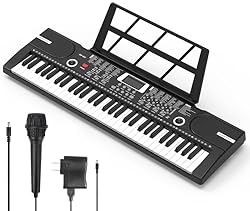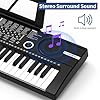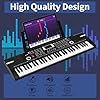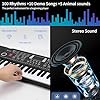Table of Contents
Introduction to Playing the Piano with an Expressive Touch
Mastering the piano involves much more than just striking the keys with precision; it requires the ability to convey emotion and dynamics through touch. Learning to play the piano with an expressive touch is essential for transforming simple note sequences into compelling musical expressions. This introduction will explore the foundational techniques and nuanced aspects of dynamic and emotional expression on the piano, providing a starting point for both beginners and experienced pianists looking to enhance their expressive capabilities.
Developing Sensitivity to Key Pressure
Sensitivity to key pressure is crucial for achieving an expressive touch on the piano. It involves understanding and controlling how the weight and speed of your finger movements affect the sound. Developing this skill allows pianists to produce a wide range of dynamics and expressions.
Yamaha Arius Series 88-Key Weighted Action Digital Piano for Aspiring Musicians, CFX Concert Grand Piano Voice, 3-Pedal Unit, Bench Included, Classic Upright Design, Dark Rosewood YDP145R
17% OffYamaha Arius Series 88-Key Weighted Action Upright Digital Piano, CFX Concert Grand Piano Voice, 3-Pedal Unit, Bench Included, Classic Upright Design, Black YDP145B
17% OffDonner Digital Piano Keyboard Velocity-Sensitive 88 Keys with Removable Piano Stand, Compact Beginner Home Electric Piano with Split Mode, LED Digital Tube for Display, and Triple Pedal DEP-08
$279.99 (as of November 22, 2025 08:02 GMT -08:00 - More infoProduct prices and availability are accurate as of the date/time indicated and are subject to change. Any price and availability information displayed on [relevant Amazon Site(s), as applicable] at the time of purchase will apply to the purchase of this product.)Donner DEP-1S Piano Keyboard 88 Keys, Beginner Digital Piano with 88 Key Velocity-Sensitive Keyboard, Record, Bluetooth, Chord, Bundle With Piano Stand, Piano Stickers, Sustain Pedal, Retro Wood Color
$219.99 (as of November 22, 2025 08:02 GMT -08:00 - More infoProduct prices and availability are accurate as of the date/time indicated and are subject to change. Any price and availability information displayed on [relevant Amazon Site(s), as applicable] at the time of purchase will apply to the purchase of this product.)Each key on the piano can be pressed with varying degrees of force, which influences the volume and timbre of the note being played. Practice employing different levels of pressure to see how it changes the character of the sound. Deliberate alteration from soft (pianissimo) to loud (fortissimo) can help in mastering this technique.
Engage in exercises that focus on controlling the touch. One effective method is to play the same note repeatedly while experimenting with different pressures and speeds to observe the subtle changes in sound. This exercise helps in developing a more tactile familiarity with the keyboard and enhances dynamic control.
Learning to transfer weight smoothly from one finger to another plays a vital role in controlling key pressure. This technique involves using the natural weight of your hand and arm rather than just the fingers to press the keys. Practice transferring weight by slowly rolling your hand across the keyboard, from pinky to thumb and back, focusing on smooth transitions.
Cultivate a habit of attentive listening to the sounds produced while playing. This heightened auditory awareness will aid in making immediate corrections to touch. It’s essential to constantly adjust the pressure based on the feedback you receive from what you hear, ensuring a more controlled and expressive performance.
Yamaha Arius Series 88-Key Weighted Action Upright Digital Piano, CFX Concert Grand Piano Voice, 3-Pedal Unit, Bench Included, Classic Upright Design, Black YDP145B
17% OffFree Piano - Learn to Play Piano
$0.00 (as of November 22, 2025 22:56 GMT -08:00 - More infoProduct prices and availability are accurate as of the date/time indicated and are subject to change. Any price and availability information displayed on [relevant Amazon Site(s), as applicable] at the time of purchase will apply to the purchase of this product.)Classical Piano for Sleep and Relaxation
$9.99 (as of November 22, 2025 22:56 GMT -08:00 - More infoProduct prices and availability are accurate as of the date/time indicated and are subject to change. Any price and availability information displayed on [relevant Amazon Site(s), as applicable] at the time of purchase will apply to the purchase of this product.)61 keys keyboard piano, Electronic Digital Piano with Built-In Speaker Microphone, Sheet Stand and Power Supply, Portable piano Keyboard Gift Teaching for Beginners
$164.00 (as of November 22, 2025 23:10 GMT -08:00 - More infoProduct prices and availability are accurate as of the date/time indicated and are subject to change. Any price and availability information displayed on [relevant Amazon Site(s), as applicable] at the time of purchase will apply to the purchase of this product.)Using Touch to Convey Emotion in Music
Utilizing varying touch techniques on the piano can dramatically alter the emotion and intensity of a piece. Each type of touch can evoke different feelings and responses from the audience, making it an essential skill for expressive piano playing.
Legato Touch
Legato, meaning “tied together” in Italian, involves playing notes smoothly and connectedly where each note transitions seamlessly into the next. This technique often evokes a sense of calmness, fluidity, and lyrical beauty. Achieving perfect legato on the piano involves careful finger transitions, ensuring that one note is released precisely as the next is played.
Staccato Touch
Staccato notes are played in a short, detached manner and are marked with a dot above or below the note head. This touch introduces a sprightly and lively character to the music, conveying feelings of joy or whimsicality. Staccato playing requires a quick, light touch where the fingers bounce off the keys, giving a crisp and rhythmic sound.
Accentuated Touch
An accentuated touch involves emphasizing certain notes to stand out from those around them, which can convey a variety of emotions depending on the context of the music. Accents can suggest excitement, surprise, or even aggression. Effective accentuation requires precise control over finger strength and timing, ensuring that the accented notes are pronounced without overpowering the piece.
Dynamic Range
Exploring the dynamic range of the piano can significantly impact the emotional content of a performance. Dynamics refer to the variations in loudness between notes or phrases. Gradual changes in dynamics, through crescendo or decrescendo, can mirror feelings of growing intensity or fading away, respectively. Controlling dynamics involves both finger pressure and the use of the piano’s pedals.
Tempo Rubato
Tempo rubato is a technique where the strict tempo of a piece is altered for expressive purposes. This can mean speeding up or slowing down certain passages, which adds an emotional depth and a sense of spontaneity. Rubato allows the performer to take liberties with the tempo to express a more personal and profound connection with the music, often reflecting nuances in timing that convey heartfelt emotion.
The Sostenuto Pedal
The use of the sostenuto pedal on modern pianos helps in sustaining selected notes while allowing other notes to be played staccato. This technique helps in creating a layered texture that adds complexity and depth to the musical narration, allowing for a nuanced interplay of sustained and muted tones that can powerfully enhance the emotional coloring of a piece.
Practicing Expressive Techniques in Different Pieces
Applying expressive piano techniques requires practicing specific methods within varying pieces. Here are several ways to enhance expression through diverse musical works:
Classical music often demands a wide range of dynamics and articulation. Focus on the phrasing and tempo modifications that composers like Beethoven or Chopin imply in their scores. Use the pedal judiciously to connect or separate notes that enhance the lyrical quality or highlight structural changes in the music. Practice playing with different levels of finger pressure and arm weight to bring out the melody over the accompaniment.
In jazz, expression often comes from improvisation, rhythmical diversity, and swing. Practice using syncopation, and explore using slight variations in timing to lay back or push forward against the rhythm. Experiment with articulations like staccatos and accents to punctuate phrases uniquely. Also, work on mastering a variety of touches, from legato to percussive playing, to suit different styles within jazz.
Romantic pieces typically contain more emotionally charged dynamics and more elaborate use of rubato. Practice controlling volume and tempo fluctuations to convey the piece’s emotional depth. Work on smooth and connected passages using the pedal and finger legato. Emphasize expressive contrasts between quiet, intimate sections and powerful, expansive climaxes.
Contemporary music can incorporate elements like atonality and unusual rhythms. Expression in these pieces can mean highlighting these unique features. Focus on accuracy in rhythm and pitch, particularly with complex syncopations or irregular time signatures. Explore different sonic textures and experiment with innovative pedal techniques like half-pedaling or flutter pedaling to achieve desired effects.
Minimalist music relies on small changes and gradual development. When practicing minimalist pieces, pay close attention to subtle shifts in dynamics, articulation, and texture. Repeat sections with slight variations each time to understand and master the slow evolution in the music. Control of repetitive motifs is crucial, making slight adjustments to keep the performance engaging and dynamic.
How to Vary Touch for Different Musical Styles
The touch and articulation you use on the piano can drastically change the feel and interpretation of the music. Different styles of music require different approaches to the keys. Here’s how you can adapt your touch for a variety of musical genres:
In classical music, the touch varies widely depending on the period (Baroque, Classical, Romantic, etc.) and the emotional content of the piece. Use a lighter, more articulated touch in Baroque pieces like those by Bach, where precision and clarity are crucial. For Romantic pieces, such as those by Chopin or Liszt, apply a richer, more legato touch to convey deeper emotion and dynamic swells.
Jazz piano requires a sense of groove and rhythm, often utilizing a syncopated touch. A key technique in jazz is the use of swing, which heavily relies on timing and velocity variations. For bebop, emphasize strong accents on offbeats, and for ballads, shift to a softer, more legato style. Experiment with different textures by incorporating both staccato and legato touches within the same piece.
The blues style is expressive and soulful, with a strong rhythmic foundation. Utilize a relaxed, laid-back touch in blues piano, particularly using techniques like grinding (rubbing the keys) and sliding (glissando) to add to the gritty, heartfelt emotion. Dynamic contrast can also help in replicating the vocal techniques symbolic of blues singers.
Rock and pop piano playing is often upbeat and strongly rhythmic. Use percussive and firm strokes to maintain energy and drive throughout songs. Chords should be played with confidence and clear articulation, helping to support the rhythmic framework of other instruments in a band setting.
In new age and ambient music, the emphasis is on creating a serene, soothing atmosphere. Utilize a soft, flowing touch, with a lot of pedal use to blend and sustain notes and harmonies. The touch should be gentle, helping to layer sounds and create a lush sound field.
When playing electronic styles on piano or keyboards, often the focus is on precise, quantized rhythms, synthesized sounds, and effects. Though an acoustic piano doesn’t offer synthesized effects, mimic this style with sharp, crisp articulations and think about timing precision. When incorporating electronic elements, like a keyboard or MIDI controller, explore varied touch responses to enhance the electronic texture.
Recording Yourself to Analyze Expressive Playing
Recording yourself while playing the piano is a crucial technique for developing a more expressive touch. By listening to your recordings, you can gain objective insights into your playing, allowing you to evaluate the dynamics, phrasing, and overall emotional impact of your performance. Here are several steps and tips on how to do this effectively:
Regularly recording and analyzing your playing can profoundly impact your ability to play piano with a expressive touch. It offers unique insights that are often overlooked during live practice sessions and can significantly accelerate your learning curve.
Conclusion
In conclusion, mastering the expressive touch on the piano involves a combination of technical skills, emotional connection, and continuous practice. Focusing on dynamics, using the weight of your arms, and understanding the emotional content of the piece will lead to a more expressive performance. Experimenting with different touches and being responsive to the feedback of your body and ears is essential. With dedication and mindful practice, players can deeply enrich their musical expression and connect more profoundly with both the music and their audience.



















































